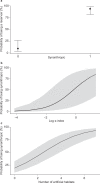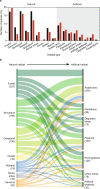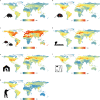Population fluctuations and synanthropy explain transmission risk in rodent-borne zoonoses
- PMID: 36477188
- PMCID: PMC9729607
- DOI: 10.1038/s41467-022-35273-7
Population fluctuations and synanthropy explain transmission risk in rodent-borne zoonoses
Abstract
Population fluctuations are widespread across the animal kingdom, especially in the order Rodentia, which includes many globally important reservoir species for zoonotic pathogens. The implications of these fluctuations for zoonotic spillover remain poorly understood. Here, we report a global empirical analysis of data describing the linkages between habitat use, population fluctuations and zoonotic reservoir status in rodents. Our quantitative synthesis is based on data collated from papers and databases. We show that the magnitude of population fluctuations combined with species' synanthropy and degree of human exploitation together distinguish most rodent reservoirs at a global scale, a result that was consistent across all pathogen types and pathogen transmission modes. Our spatial analyses identified hotspots of high transmission risk, including regions where reservoir species dominate the rodent community. Beyond rodents, these generalities inform our understanding of how natural and anthropogenic factors interact to increase the risk of zoonotic spillover in a rapidly changing world.
© 2022. The Author(s).
Conflict of interest statement
The authors declare no competing interests.
Figures





References
-
- Krebs CJ, Myers JH. Population cycles in small mammals. Adv. Ecoligical Res. 1974;8:267–399. doi: 10.1016/S0065-2504(08)60280-9. - DOI
-
- Singleton GR, et al. One hundred years of eruptions of house mice in Australia–a natural biological curio. Biol. J. Linn. Soc. 2005;84:617–627. doi: 10.1111/j.1095-8312.2005.00458.x. - DOI
-
- Jaksic FM, Lima M. Myths and facts on ratadas: Bamboo blooms, rainfall peaks and rodent outbreaks in South America. Austral Ecol. 2003;28:237–251. doi: 10.1046/j.1442-9993.2003.01271.x. - DOI
-
- Krebs, C. J. Population Fluctuations In Rodents. (The University of Chicago Press, 2013).
-
- Oli MK. Population cycles in voles and lemmings: state of the science and future directions. Mammal. Rev. 2019;49:226–239. doi: 10.1111/mam.12156. - DOI
Publication types
MeSH terms
LinkOut - more resources
Full Text Sources
Research Materials

